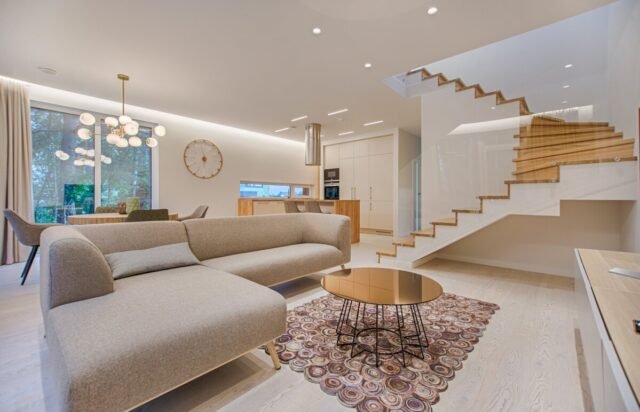Your home is your sanctuary. It’s a reflection of who you are and what you love. From the colors on the walls to the art on display, your décor tells a story about your unique personality and passions. Creating a space that truly embodies your personal style takes thoughtfulness and care, but the payoff is immense. A home that feels genuinely “you” can lift your spirits and bring joy every single day.
Discovering Your Decorating Style
The first step in creating a home that reflects your personal style is identifying what that style actually is. Taste in interior design is deeply personal, influenced by your interests, experiences, and personality traits. Start the style discovery process by asking yourself some introspective questions:
- What colors make you happy? Are you drawn to bold hues like emerald green and cobalt blue or prefer muted tones like dove grey and blush pink?
- What patterns and textures do you lean towards? Do you love the coziness of cable knit blankets or the sleekness of polished marble surfaces?
- Do you have favorite eras or cultures that inspire you? Victorian architecture or midcentury modern design, for example.
- Which rooms in your home do you spend the most time in? Focus on creating an amazing decor sanctuary for the spaces you use daily.
- How would you describe your lifestyle and personality? Casual and laidback or formal and elegant?
Once you’ve reflected on your interior design preferences, consider how they fit into some of the most popular decorating styles:
Minimalist
The minimalist style is all about simplicity. It focuses on clean lines, plenty of open space, and a limited color palette. Key elements in minimalist rooms include neutral furniture, multipurpose pieces, and lots of natural light.
Boho Chic
Bohemian or “boho” style embraces freedom of expression. This look features rich textures like velvet and leather, eye-catching patterns like paisley and ikat, and an eclectic mix of furnishings from different eras and cultures.
Modern
Modern decor emphasizes sleek, contemporary pieces. You’ll see solid colors, geometric shapes, and natural materials in a modern home. The look leans towards functionality and flexibility over ornamentation.
Farmhouse
The farmhouse style is inspired by practical country living. It focuses on natural materials like wood and stone with distressed finishes. Airy, open floor plans and floral accents are farmhouse trademarks.
Traditional
Traditional design draws inspiration from classical European styles. This elegant look often features decorative molding, rich colors like burgundy and navy, and luxurious furnishings. Symmetry and order are emphasized in traditional décor.
Once you’ve narrowed down the style categories you’re drawn to, it’s time to dive deeper into choosing the specific elements that will make your home distinctly “you”.
Laying the Foundation: Color Palettes and Textures
Color is one of the most impactful design elements. The hues you choose for your walls, furnishings, and accents set the entire mood for each room. When selecting a color palette, consider the purpose of each space along with your personal preferences.
The psychology of color also greatly influences how certain hues make us feel. For example:
- Blues and greens foster relaxation and tranquility. Perfect for bedrooms and spas.
- Neutrals like beige and gray promote concentration and clarity. Ideal for offices or studies.
- Vibrant shades like crimson and gold evoke excitement and cheer. Great for dining rooms and living areas.
Don’t be afraid to use color to create defined spaces within a larger room. A bold blue accent wall in a neutral living room immediately draws the eye, becoming a focal point.
Texture adds visual and tactile interest to your décor. Incorporate a range of textiles to keep rooms from feeling flat and one-dimensional. Play with different textural combinations like:
- Plush wool rugs underfoot and silky curtain panels framing windows
- Sturdy jute placemats contrasting sleek marble tabletops
- Cozy cable knit throws atop smooth leather sofa cushions
Vary textures throughout the home to define each space while still creating a cohesive feel.
Furniture Selection: The Art of Curating Pieces
Furniture forms the foundation of any interior design scheme. Scale and proportion are key considerations when selecting pieces. Make sure furnishings fit the room properly and don’t overwhelm the dimensions. Other tips for choosing furniture include:
Consider Your Lifestyle
Your furniture should suit how you actually live. If you entertain often, prioritize cozy seating and spacious tables. For a busy family, focus on durable, easy-care pieces.
Choose Timeless Over Trendy
Quality furnishings that reflect your authentic style won’t date your home. Seek out classics like a leather Chesterfield sofa or mid-century modern credenza.
Mix Old and New
Give rooms more depth by blending antique or vintage finds with modern designs. An industrial metal coffee table looks striking beside that tufted vintage armchair.
Multifunctional is Best
Make the most of your space with furniture that serves more than one purpose. An ottoman that opens into storage or a bench that folds out into a guest bed.
Curate Slowly
You don’t have to furnish an entire home all at once. Thoughtfully collect special pieces over time for a layered, collected look.
By keeping functionality and your personal taste top of mind, you’ll end up with a home full of furniture you’ll cherish for years to come.
Accessorizing with Personality: The Finishing Touches
Accessories are the jewels that take your design scheme from basic to beautiful. These are the items that inject your personality into a space, telling visitors a story about who you are.
When accessorizing, first take note of what’s missing in a room. If a bookshelf looks bare, add framed family photos or potted plants. If a fireplace mantel seems empty, arrange artful ceramic vases on top. Address the blank spaces.
Next, think about your interests and what makes you uniquely “you”. Music lover? Display vintage records and a guitar. Avid traveler? Group souvenirs from different countries together on a console table. Showcase what you love.
Some other ways to accessorize with personality:
- Artwork – Hang pieces that speak to you or even your own creations. Mix mediums like photography, paintings, and prints.
- Textiles – Roll out a vibrant rug, hang cozy macrame wall hangings, or display beautiful fabric swatches.
- Sculptures – Add visual interest with carved wood or molded metal sculptures in corners or recessed wall niches.
- Plants – Greenery instantly livens up any space. Cluster potted plants on shelves or hang trailing vines.
The beauty of accessories is you can easily change them up whenever the mood strikes. Have fun with it!
Lighting: Illuminating Your Style
Lighting completes a room, creating the perfect ambiance to match your personal style. There are three main types of lighting to factor in:
Ambient: This is the soft, general illumination for the whole room. Overhead ceiling fixtures or table and floor lamps often provide ambient lighting.
Task: As the name implies, this is targeted light for completing specific tasks like reading or cooking. Under-cabinet kitchen lighting is a great example.
Accent: Accent lighting highlights specific design elements or areas. Picture a beam of light over a piece of art or wall sconces framing a mirror.
Choose fixtures and bulbs that complement your decorating style. For modern spaces, sleek track lighting and LEDs give a streamlined vibe. In cozy farmhouse rooms, wrought iron chandeliers and Edison bulbs set a welcoming mood.
Don’t underestimate natural light either. Maximize sunlight by hanging mirrors across from windows to amplify the brightness. Install sheer curtains to filter light softly into rooms.
Proper lighting illuminates your home in the best possible way, highlighting the design details you’ve so thoughtfully selected.
Final Touches for a Home That Reflects You
Creating a space that truly reflects your personal style requires self-awareness, patience, and a bit of experimentation until you land on what feels “just right”. But the payoff is priceless – your home becomes a direct representation of what inspires you, what you cherish, and who you are.
A few final tips for infusing personality into your décor:
- Display, don’t hide away pieces with emotional significance. The antique clock inherited from your grandmother or the hand-woven wall hanging purchased on your honeymoon, for example.
- Redesign rooms over time as your tastes evolve. You should never feel stuck with a look you’ve outgrown.
- Break the “rules” if certain guidelines don’t align with your vision. You don’t have to follow trends if mid-century modern is your spirit style.
- Have fun and don’t stress small stuff! Remember, this is your personal sanctuary. Make bold choices that bring you joy.
The most important takeaway? Decorate based on your own definitions of beauty, comfort, and style. With your unique stamp on every room, you’ll create a home that truly feels like you.































